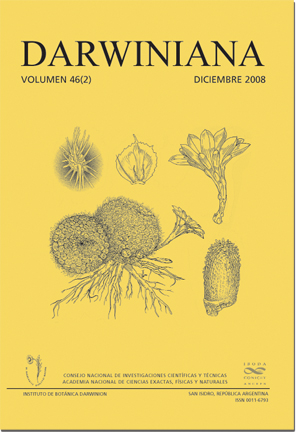Voices in the forest: hunter-gatherers use of vegetable resources in the central part of Tierra del Fuego (Argentina)
DOI:
https://doi.org/10.14522/darwiniana.2014.462.70Keywords:
Archaeobotany, hunter-gatherers, Selknam, Tierra del FuegoAbstract
We studied the different ways of plant use among the Selknam from Tierra del Fuego (Argentina). In this paper we present the results obtained from the study of carbonized and non carbonized wood remains recovered at Ewan site, which was occupied at the beginning of the XXth century to celebrate an initiation ceremony. Results allowed a better understanding of the strategies of plant use in hunter-gatherer societies. The identification of the species used, and the analysis of their principal morphometric characteristics characterize the use of the “Ñire” (Nothofagus antarctica). This species, dominant in the surroundings, was used to build the dwelling as well as for fuel. For both uses, stems with suitable form and size were selected. Archaeobotanical results and their confrontation with the ethnographic data support the importance of vegetable resources within the socio-economic dynamics of the selknam society. Vegetable resources, beyond their use as food, were important in other aspects, such as technology, hut construction, fuel, and they certainly represented a considerable advantage in the area of the forests of the central zone of Tierra del Fuego.Downloads
Published
31-12-2008
How to Cite
Caruso, L., Mansur, M. E., & Piqué, R. (2008). Voices in the forest: hunter-gatherers use of vegetable resources in the central part of Tierra del Fuego (Argentina). Darwiniana, Nueva Serie, 46(2), 202–212. https://doi.org/10.14522/darwiniana.2014.462.70
Issue
Section
Archeobotany and Ethnobotany
License

Starting on 2012, Darwiniana Nueva Serie uses Licencia Creative Commons Atribución-NoComercial 2.5 Argentina .






